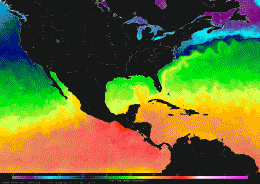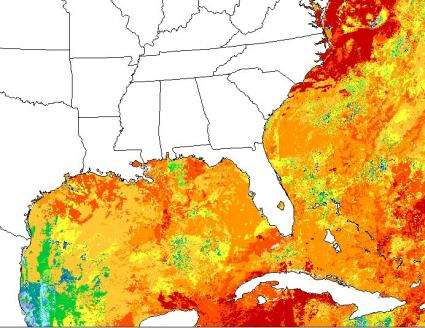NASA Scientists Monitor Ocean Temperatures to Understand Weather

(PhysOrg.com) -- Earth's oceans and atmosphere are engaged in a complex dance, continually exchanging heat and moisture. Ocean conditions directly influence the conditions of the atmosphere. To predict our weather, forecasters need the best information they can get about the state of affairs in the sea. That's where the Short-term Prediction Research and Transition, or SPoRT, project at the Marshall Space Flight Center steps in. The SPoRT team uses NASA Earth observation satellite sensors to provide ocean temperature updates to the National Weather Service four times daily. The SPoRT scientists recently enhanced their ability to detect changes in sea surface temperatures -- a variable that greatly affects weather in coastal regions -- and the public will benefit.
The SPoRT project is expanding its reach too. The previous sea surface temperature product covered the Gulf of Mexico and the southern and eastern coastlines of the U.S. The new coverage region will include all of the ocean areas surrounding North America, from the Hawaiian Islands to the middle of the Atlantic, and from Hudson's Bay and the Gulf of Alaska to the equator, including the tropical oceans where hurricanes form.
"Our enhanced sea surface temperature product brings in more data, allowing more up-to-date and accurate inputs into weather forecasts," explains Dr. Gary Jedlovec, satellite meteorologist and SPoRT principal investigator. "We're also expanding the coverage area, benefiting more communities along the coastal regions."
"Much of the energy for weather systems comes from the ocean," adds Frank LaFontaine, a SPoRT meteorologist. "That's why the sea surface temperature is so critical to forecasters. Many storm systems like to form and/or intensify over warm water, where there's a lot of potential energy for them to tap."
LaFontaine says that the new product will help even help researchers detect thermal currents and eddies, which are important because clouds tend to form along those lines.
"For instance, tropical depressions often start forming out at sea and strengthen over the warm tropical waters," explains LaFontaine. "Variations in sea surface temperatures in coastal regions can further strengthen or weaken the storm as it makes landfall."
The SPoRT team says the data provided by their new product could help forecasters predict how intense hurricanes or tropical storms will be.
"A hurricane can ramp up offshore in intensity level so quickly, there's not enough time to warn the public," says LaFontaine. "Our product could help with predicting that intensity surge."

The enhanced product achieves its improved level of detail by adding microwave readings from the Advanced Microwave Scanning Radiometer, or AMSR, a sensor aboard NASA's Aqua satellite, to the data already in use by the previous version of the SPoRT product. That version incorporated only infrared data from the MODerate-resolution Infrared Spectrometer, also known as MODIS, aboard the Aqua and Terra satellites. The microwave data complements the infrared data in an important way.
"Microwaves can penetrate the clouds, allowing us to take data over both clear and cloudy areas," says Jedlovec. "The old version of our product left gaps where the clouds were."
The data allows the scientists to resolve small changes in the temperatures at the ocean's surface at 1-kilometer, or 0.62 mile, intervals. To put it simply, if the water temperature varies 0.2 degrees Celsius, or 0.36 Fahrenheit, between a 1 kilometer square area and the next, they can detect that difference. This level of detail improves the models used to predict weather.
Provided by JPL/NASA



















